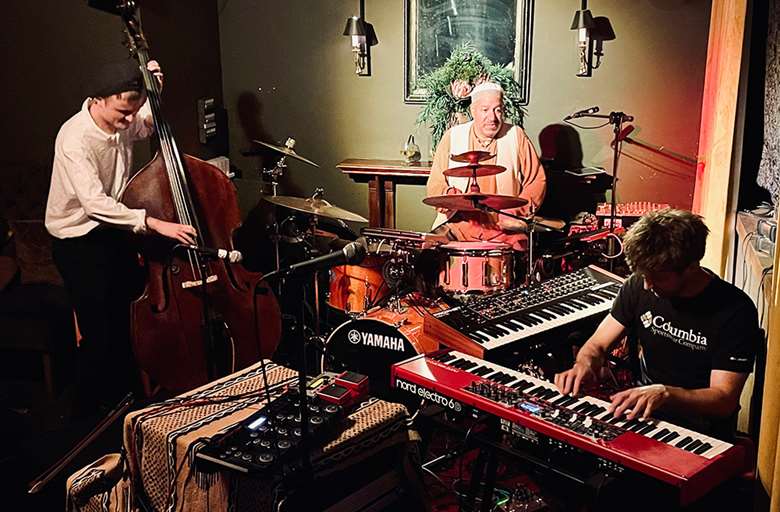Marque 'Da Innamost' Gilmore makes moves at the CLF Art Lounge, London
Kevin Le Gendre
Wednesday, May 18, 2022
The expat New York drummer taps into a post-Jungle jazz sound-world that traverses electronica, improv and Indo-jazz with his versatile quartet

Although it is a long way from west end jazz clubs CLF Art Lounge in Peckham Rye, in the south east of the ‘big smoke’ has a dignified decor by way of pictures to rival Ronnie’s – portraits of Monk, Mingus and Trane, entre autres, make for an impressive wall of fame, while the array of tables sets the mood for serious listening. That indeed happens when the Stockholm-based Marque Gilmore and special guests start their set, but the irony is that by the end of the evening several punters have taken leave of their seats, lent an ear to their bodies and responded to the sounds in the most appropriate way: dance.
Therein lies the importance of Gilmore, who traded New York for London in the 1990s and became the original ‘jungle drummer’, providing thrillingly high bpm for Project 23 alongside Cleveland Watkiss and DJ Lerouge as well as leading his own ambitious Millennium Migration ensemble whose avowed cultural mission was to sound-travel from ‘Brooklyn to Bombay To Brixton To Bamoko’ Gilmore’s ability to network different points in the black Diaspora and stand at the crossroads of African, African-American and black British musical histories remains an integral part of his identity, and this outstanding session confirms he is a vital trans-cultural innovator.
Joined by double bassist Hamish Nockles Moore, keyboardist Lazy H and vocalist PLUMM, Gilmore both upholds and extends the role of a kit drummer by blending dynamic polyrhythmic patterns with the hisses and hums of electronic consoles that make his whole set-up unique. Kick, snare and cymbals are completed not by toms but slimline machines that give Gilmore the appearance of a synthesizer player who uses sticks instead of fingers. Which makes the moments when the technology cuts out all the more interesting because the drummer’s flawless command of pulse and acoustic texture really comes to the fore.
It’s not just that he has the relentless double time drive of what is now known as drum & bass down pat, but more that he has unerringly clear articulation on those whizzing sixteenth note cycles that make you realize that it is the staccato precision of each line, as if they were sculpted into the air, that counts as much as runaway tempo. It is a strange stillness within speed. Or a lesson that funk is all the heavier when it calmly freezes rather than gets crazy frantic.
Moore and H fit right into this way of thinking, with the former creating a blend of drilled, percussive syncopations and longer undulating motifs, and the latter alternating punchy, busy electric piano licks and glistening, quasi-underwater chords, to give the voicings liquidity as well as solidity. PLUMM reinforces this with wordless vocal, morphing into electronica when she uses an effects processor. But once again the performance scales another height when things get unplugged, or rather set off universal vibrations. Gilmore playing with fingers and palms brings new layers of crispness to the sound palette that shifts geo-cultural perceptions. The snare becomes a Malian djembe, Indian tabla or Moroccan bendir and the parallels between African and Asian traditions and modern western dance music are there for all to hear. This time-stretch galvanizes a fully improvised set in which Gilmore finishes by beat-boxing the low end into life, reminding us that if hands are drums then bass is voice.
The gig happens on Friday the 13th. From up on the wall Monk surely gives his blessing.